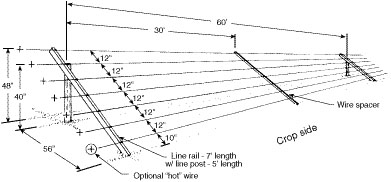

The vineyard is roughly 2 acres in size and has a fairly "vanilla" design that we are using to assess the hardiness, performance and quality of 19 different red and white Vinifera grapes. Essentially, the vineyard is an agricultural experiment. In a few years, we will plant commercial quantities of a selection of grapes based on the test plot performance. We're less interested in producing any specific variety of grape than in identifying the best quality grapes for our farm.
The vineyard is comprised of 17 rows that are 350' in length. Vines are spaced 6 feet within rows and 8 feet between rows, which translates into a vine density of 908 vnes per acre. This is a fairly common planting arrangement for U.S. vineyards. The rows are oriented north-south for even sun exposure.
Pruning decisions and the choice of trellis system can have an enormous effect on grape yields and wine quality. For the time being, we are using a "vanilla" approach and will make alterations in training based on experience at our site. Our oldest vines are now in their fourth season. Cold winters and deer reeked havoc with our training efforts in the springs of 2007 and 2008, but we have solved the deer problem (see below). We are now training the vines into two trunks, which should provide insurance against possible loss of trunk during severe winter cold. Our goal is to establish cordons (essentially horizontal, woody trunks) with fruiting spurs. This approach requires less skilled labor than the cane-pruning approach, although the cane pruning approach may be desired for some grape varieties and vineyard conditions.
We are using a Vertical Shoot Position (VSP) trellis system. This approach uses a single fruiting wire to which the cordons are attached. The grapes grow from the spurs on the previous year's wood. The leafy, new growth is trained upwards between pairs of moveable "folliage wires."

In 2007 (and much of 2008), the local deer enjoyed a nightly meal of tender grape leaves, which disrupted our pruning efforts. So, we put up an electrified, 7-wire slanted fence in 2007 to deny them this simple pleasure, but the system did not work as planned (the deer pushed through the lower wires). In 2008, we added four feet of polypropylene deer fence to the bottom of the fence, which we thought had solved our problem. However, in October of 2010 the deer forced their way through the electric fence to feast on ripe grapes. Next year we'll raise the fence to 8'.
We do not currently employ any frost protection, but wind machines or microsprinklers will be needed to produce commercial quantities of grapes. At the other end of the property, temperature sensors show 2 degrees or more of protection during frost events on our acreage that overlooks Brownlee Reservoir.